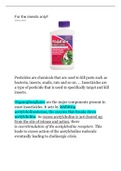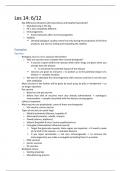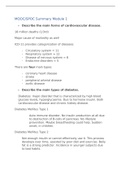Advanced Subsidiary
Main Mistakes
Significant figures vary in the question
- If the question has data that are taken in the least significant figures
- the significant figures taken should be in question but not constant
- For pH, always take 2.d.p
- If one of the error is three times larger than the all of the other errors, the other errors could be
neglected
Absorb water, H2SO4, absorb CO2 in alkaline
Safety precautions (includes 90% of answers to handle these questions)
- Wear safety goggles
- Wear protective gloves
- Do the experiment behind the fume cupboard
Basic ideas about atoms
NOTE: when mentioning the atomic structure of isotopes
- explain with protons electrons and neutrons but not mass number and atomic number
- always state that they have the same number of protons AND ELECTRONS (as they are atoms)
- If they are not atoms, they would have the same number of protons but different number of
electrons
- also state that they have different number of neutrons
Reduced Oxidising agent (gain electron/ lose oxygen)
Oxidised Reducing agent (lose electrons/ gain oxygen)
Always name the ion instead of atom (of having charge) i.e. use Na+ not Na in NaCl
Oxidation numbers
- Element 0
- Group 1 ions: always +1
- Group 2 Ions: always+2
- Halogens: usually -1, Positive with Oxygen
- Monoatomic ion: ion charge
- H: +1 with non metals, -1 with metals
- O: usually -2, -1 with peroxide (H2O2)
- F: always -1, even with oxygen
- Sum of oxidation numbers for a neutral compound=0
- Sum of oxidation numbers for a polyatomic ion= ion charge
Describe the way in which electrons are arranged in atoms
- Electrons within atoms occupy fixed energy levels or shells of increasing energy
- Electrons occupy atomic orbitals within these shells/ first shell has s orbitals and the second
shell s and p orbitals
, - A maximum of two electrons can occupy any orbital
- Each with opposite spins
- There are 3 p orbitals in xx’ p subshell
- In XXX p sub shell each orbital contains one electron
Half life
- Longer half-life cause that substance to exist longer
- good in industry as no need replace that much
- not good in medicine as if exist in body too long may harm the body
They are deflected by an electrical field (towards the positive or negatively charged plates)
◦ magnetic field has different direction, determined by Fleming's left-hand rule
Alpha particles
- High ionising power
- low penetrating power (could be blocked by a thin paper)
Beta particle
- Medium ionising
- Medium penetrating power (could be blocked by thick sheet of aluminium)
Gamma ray
- Low ionising power
- High penetrating power (could be blocked by thick (NOT thin) lead, a metre concrete)
Radioactivity is harmful as it damages DNA (dun say liver cancer, second priority)
Uses of Radioactive substances
,- Cobalt-60 in radiotherapy for treatment of cancer
- Carbon-14 radio dating
- Potassium-40 estimate the geological age of rocks
- Measure the thickness of strips or foils
It is not suitable to measure half life for electron capture and beta minus emission when there is:
- no change of mass
- isotope produced and initial isotope would produce one peak in mass spectrum
When considering measuring the radioactivity over time, BOTH SAMPLES WILL DECAY unless it
is not radioactive, so need take into account during calculation
Calculate the mass of the element from the Radioactivity (Bq per cm3 of the solution)
- Multiplying by the time would give the number of the atoms produced per time
- Divide it by the Avogadro’s number
o Get the number of moles, and converting to mass
o Calculate the number of mass produced per unit time
Identify the original isotope present in greatest concentration in the solution
◦ find the highest radioactivity of the element
◦ compare it with the half life
◦ even the element is not the highest radioactivity, if it has a relatively long half life, so there
must be a greater amount in order to produce this amount of radiation
‣ the radioactivity represents the immediate moment
How does the decay (Bq) relates to the half life
Larger half life does not mean its not harmful
◦ If the isotope is still present, it still has radioactivity
◦ There maybe other radioactive nuclei not detected
◦ The decay of a radioisotope may produce another radioactive nuclei with a longer half life
Thought experiment
There are 100 Chlorine-38 (half life 37 mins) atoms and 100 Caesium-137 atoms (half life 30 years)
- The radioactivity of Chlorine would be much higher than Caesium-137
- (It takes 30 years for Cs to decrease to 50 while it only takes 37 mins for Cl to decrease the same
amount)
However, the table shows that the radioactivity is the same
, When the amount increase, for the same half life, the radioactivity increases
(200 atoms, it now takes 30 years to decrease by 100, 50 (there is increase in rate of decrease))
- Only a large amount of Cs would be here to have the same amount of rate of decrease
(radioactivity) with Cl
Difference of energy levels are fixed
- Not energy levels are fixed (Only certain definite frequencies of visible light)
Emission spectrum
Do not say that it jumps back to the Balmer series, say that it jumps back to n=2
◦ The Balmer series is the atom that jumps from any energy level to n=2, but not jumping
back to the Balmer series, same idea for other series
◦ The series would form different photons with different wavelength, as they are in different
starting point
• If larger jump, (convergence to n=1) it should be Lyman series in the ultraviolet region as higher
energy difference, photon have higher energy
• Paschen series corresponds to infra red
• Atomic spectrum of hydrogen is a series of lines that gets closer as their frequency increases
State energy (levels) in an atom are quantise
Filling the electrons
fill them in turn by 1s2 2s2 2p6 3s2 3p6 4s2 3d10 4p6
except for 2 elements
Cr: 1s2 2s2 2p6 3s2 3p6 4s1 3d5 (NOT 4s2 as the element is half filled in the 3d shell)
Cu: 1s2 2s2 2p6 3s2 3p6 4s1 3d10 (NOT 4s2 as the element is fully filled in the 3d shell)
However the rule still applies to Vanadium (NOT 3d5 is 4s2 3d3) and Ni (NOT 3d10, should be 4s2
3d8)
Assume 4s2 electron really so low that can need to be filled first compared to 3d
S subshell: Sphere
P subshell: dumbbell shape
Every time talking about ionisation energy, in whatever case, mention gaseous state
Polar covalent bond ≠ Coordinate bond (see definition notes)
Why the second IE is higher than the first IE
- there is a greater effect of nuclear charge
- the second electron is in a different electron shell compared to the first one, reduces shielding, so
have LARGE increase
Format
- Mention number of protons (Nuclear charge)
- Shielding affect
- the electron needed to be removed/ outer electron closer/further to the nucleus
- Attraction of electron to nucleus
- Before write these remember state that they are in the same period
Examples










